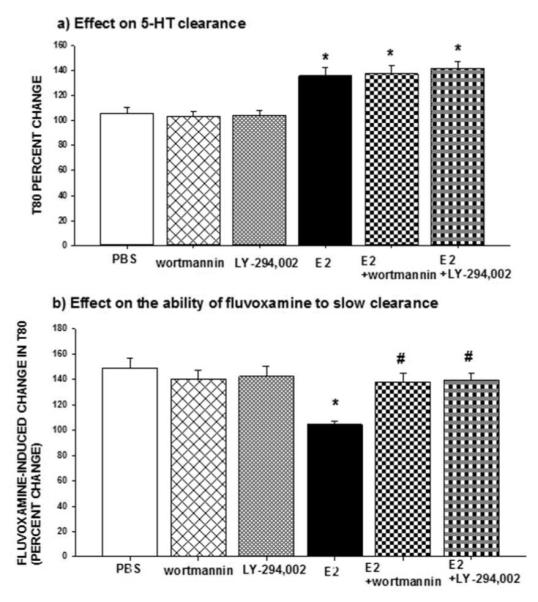Figure 3.

Effects of inhibitors of PI3K/Akt on estradiol’s effects on SERT function. Selective inhibitors of PI3K/Akt, wortmannin (50ng) or LY294,002 (30μg), were applied locally into the CA3 region of the hippocampus 15min prior to local application of 17-β-estradiol (E2; 20 pmol), and their effects on:
(a) The clearance time parameter T80 were measured at 10 min post E2 administration. Bar and brackets represent the T80 value as a percentage of the pretreatment value ± SEM (n = 5–7); Two way analysis of variance was carried out for the percent change in T80 values for E2 and/or inhibitors. There was no significant main effect for inhibitor [F(2,29)=0.148, p=0.863] but there was a significant main effect for E2 [F(1,29)=56.982, *p<0.001] and no significant interaction between inhibitor x E2 [F(2,29)=0.258, p=0.774].
(b) The ability of fluvoxamine to increase the T80 value was measured at 10 min post E2 administration. Bar and brackets represent the percent change in T80 value after fluvoxamine ± SEM (n = 4–12). The data were analyzed by a two-way ANOVA. The percentage change in the T80 value produced by fluvoxamine was the parameter analyzed and the effect of E2 in the absence or presence of the inhibitors was evaluated. There was a significant main effect for inhibitor [F(2,34)=3.114, p=0.05] and for E2 [F(1,34)=9.759, p=0.004] as well as a significant interaction between inhibitor x E2 [F(2,34)=7.782, p=0.002]. Dunnett’s post hoc analysis was carried out. *p < .001, comparing E2 within PBS and #p < .001, comparing value of E2 with inhibitor to value of E2 alone.
